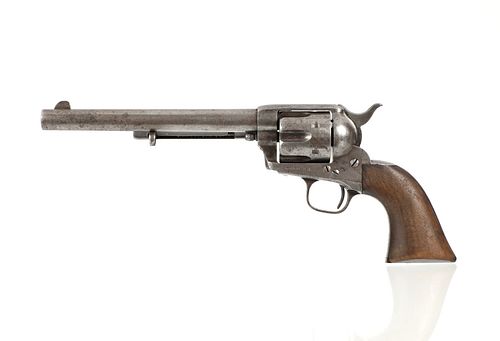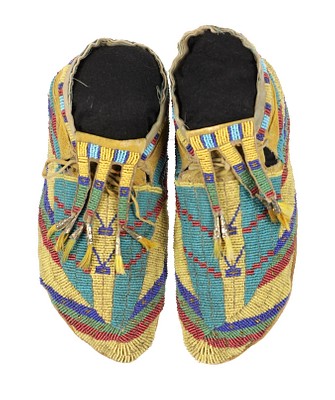Little Bighorn Surgeon J.M. DeWolf's US Colt SAA
Two ways to bid:
- Leave a max absentee bid and the platform will bid on your behalf up to your maximum bid during the live auction.
- Bid live during the auction and your bids will be submitted real-time to the auctioneer.
Bid Increments
| Price | Bid Increment |
|---|---|
| $0 | $5 |
| $50 | $10 |
| $100 | $25 |
| $500 | $50 |
| $1,000 | $100 |
| $2,000 | $250 |
| $5,000 | $500 |
| $10,000 | $1,000 |
| $25,000 | $2,500 |
| $100,000 | $5,000 |
About Auction
Nov 12, 2022
Join us for our Best of the West Auction, November 12th, 2022. This will be our last Collector sale of the year and includes a large collection of antiques from the West, Montana and Santa Fe Western Art Collection, Navajo Jewelry and Rug collection, as well as many other pieces. North American Auction Company tucker@naabid.com
- Lot Description
Offered in this lot is the sale highlight and one of the most important and historic pieces, a Battle of the Little Bighorn Surgeon James Madison DeWolf owned Colt Model 1873 Single Action Army U.S. 45 Caliber revolver inspected by A.P. Casey, as well as from Crawler a Blackfeet Chief and accompanied by a Kopec letter. The revolver marked on the side with initials “SJMD (S J M D)” FOR Surgeon James Madison DeWolf. It is also marked in Lakota Togia, Crawler Blackfeet several times (see illustrations). Custer instructed everyone in the U.S. 7th Cavalry to mark their weapons and it is thought the DeWolf added the “S” to denote his contract surgeon status and differentiate from the other men with similar initials. Crawler as born in 1830 to Blackfeet parents and headed the Fool Soldier Society of the Blackfeet and joined the Silent Eaters as the Blackfeet representative. Crawler married Pretty White Woman in 1854 having several children. He was close friends to Sitting Bull and always camped in Sitting Bull’s Hunkpapa circle. Crawler’s Blackfeet band fought in many of the Indian Wars including the Battle of the Little Bighorn, Greasy Grass. He followed Sitting Bull into Canada and surrendered with him in September 10, 1881 at Fort Buford and was transferred to Standing Rock Reservation where he and his band settled eight miles north of Bullhead, South Dakota. Crawler died in 1911 and was buried in Old Kenel, South Dakota. Many of his direct descendants remained near Bullhead and were employed by Wendell Grangaard when his company built the Bullhead Dam in the 1980’s. His descendants state that at the Battle of the Little Bighorn Crawler saw a man in a blue civilian coat who he killed and took this revolver out of his long over coat. Also included in the lot is the journal entries of Dr. James Madison DeWolf. DeWolf was born in 1843 and served in the Union Army in the 1st Pennsylvania Artillery, becoming Corporeal before he was severally wounded and discharged in October 1862. After re-enlisting in September 1864 in Battery A, 1st Pennsylvania Artillery where he served until discharge in June 14 1865, the war ended and DeWolf re-enlisted in the 14th US Infantry of the Army and served as a hospital steward for two years. In May 1872 DeWolf was admitted into Harvard Medical School through an agreement with the Army and in May 1875 he received the certificate of passing the required examination by Calvin Ellis, the Dean of Harvard Medical School with his degree to be received in June. He was denied due to his age for commission into the Army, but later he obtained a contract as an assistant surgeon with the Army on October 16, 1875. He was assigned to serve the Department of the Dakotas and sent to Fort Totten in Dakota Territories. On March 2, 1876, Dr. DeWolf received Special Order No. 27 from General Alfred H. Terry, which ordered him to accompany Companies E an L of the 7th Cavalry from Fort Totten to Fort Abraham Lincoln and report to General George Armstrong Custer. Written out in the historical examination of the revolver is sections from Assistant Surgeon James DeWolf, using his diary and letters to his wife Fannie. The diary stats on the day he left Fort Totten and details the events of his final journey. Noted dates and entries as follows: April 22, 1876I got some blue clothe from the Q. M.D. Today I am getting a pair of blue shirts made so I will have them to wear under a coat…; April 25 got my two new blue shirts today..; June 21 …I think it is very clear that we shall not see an Indian this summer. I went out with Dr. Porter, Lt. Harrington and Hodgson pistol shooting and came out second best to Porter, Cavalry cannot shoot very well; June 24 Marched west on trail, Found lots of new signs; End of Entries. On the morning of June the 25th, 1876 Custer assigned Dr. DeWolf and Dr. Porter to Reno’s divisions. Reno was to spearhead, and he attacked the south village (Sitting Bull’s Hunkpapa). Dr. Porter, a survivor, testified later that he rendered medical assistance to many men in the timber along with Dr. DeWolf. Crawler at the time was camped on the south-east side of the Hunkpapa camp, which put him in the direct path of Reno’s companies of horse soldiers. A more detailed account from the descendants as well as the journal entries are in the historical examination. Crawler said “I saw a man who was not dress like a soldier. He had a large brimmed hat, long overcoat and wearing bright blue shirt. He was carrying a wooden box. I liked the wooden box and his shirt. I thought the box must be special to the man because his horse was going crazy but he did nothing but hold onto the box. I just had to have that box.” Crawler then killed the man, took his box and when trying to remove his overcoat found the revolver in the pocket and forgot the shirt. Crawler said “I took my knife and opened the box. All I found were some knives, but I did not understand why the box was so important to the man.” Crawler encountered Reno’s division and only two surgeons who would have carried these surgical instrument boxes were in Reno’s command, one survived the fight, Porter and the other was killed by Crawler, Dr. Surgeon DeWolf. It is believed that this revolver was part of the 115 revolvers ordered by Custer from Colt as part of the Order 117 which were shipped to Schuyler, Harley and Graham in New York, New York so that Custer could have them altered to his specifications, enclosed in the examination is a copy of the leter from Colt for serial number 13721, which is one of the revolvers that was nickel plated by Adams Plating Company throught Schuyler, Harley and Graham, as instructed by Custer and later issued to One Horn, one of Custer’s Arikara Scouts. This example is considered by Grangaard as one of the most well documented items from the Battle of the Little Bighorn due to DeWolf journal and letters as well as the Crawler testimony supported by his family. Attached is the Arikara Scout 1873 Colt List with this revolver being listed as from Dr. James DeWolf – Contract Surgeon. Also included is the John A. Kopec letter stating that this revolver, serial number 16701 was perfectly authentic in every respect being A.P. Casey inspected and falling one serial number from another U.S. Cavalry revolver documented by Kopec, number 16702. This is truly one of the finest U.S. 7th Cavalry revolvers with both historic information from both the cavalry and Native American side. Included with the firearm is the signed historicial examination from Wendell Grangaard which includes the DeWolf journal and letter entries, the Crawler family testimony, and many illustrations. Also included is the Kopec letter, example of the Order 117 ordered Colt Letter, and Colt Arikara Scout documented list with this gun present. Antique Firearm does not require an FFL.
- Shipping Info
-
North American Auction Company is proud to announce the opening of our new in-house, full-service shipping department. We have listened to you the customer and will now be handling all outgoing packages in our new shipping department. We are confident this new offering will allow for a smooth transition from auction block to your front step. We have partnered with preferred carriers to ensure a safe, efficient delivery that works best with your schedule. Please allow 14-21 days after complete invoice payment is made to package and ship your purchase. After you are notified of your winning bids from our company and your item invoice is paid in full our new shipping department will contact you. Make sure when signing up with our company that your preferred shipping information is up to date as this information will be used to estimate shipping cost. Once the items have been packaged our team will contact you for shipping payment. Shipping invoices and payment will be completely separately than the items invoice. Please notify the shipping department with any alternate request or instructions at mark@northamericanauctioncompany.com or 800-686-4216 ext. 3. For a shipping quote please contact the same information above. PLEASE NOTE a shipping quote price can fluctuate in price. Auction company is not responsible for actual shipping cost being higher than quoted shipping cost. Thank you for trusting North American Auction Co. with your bids and shipping. As our shipping department is brand new please understand that delays can be expected.
-
- Buyer's Premium



 EUR
EUR CAD
CAD AUD
AUD GBP
GBP MXN
MXN HKD
HKD CNY
CNY MYR
MYR SEK
SEK SGD
SGD CHF
CHF THB
THB

















































